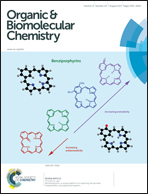DFT studies on the directing group dependent arene–alkene cross-couplings: arene activation vs. alkene activation†
Abstract
Due to its green-chemistry advantages, the dehydrogenative Heck reaction (DHR) has experienced enormous growth over the past few decades. In this work, two competing reaction channels were comparatively studied for the Pd(OAc)2-catalyzed DHRs of arenes with alkenes, referred to herein as the arene activation mechanism and the alkene activation mechanism, respectively, which mainly differ in the involvement of the reactants in the C–H activation step. Our calculations reveal that the commonly accepted arene activation mechanism is plausible for the desired arene–alkene cross-coupling; in contrast, the alternative alkene activation mechanism is kinetically inaccessible for the desired cross-coupling, but it is feasible for the homo-coupling of alkenes. The nature of directing groups on reactants could mainly determine the dominance of the two competing reaction routes, and therefore, influence the experimental yields. A wide range of directing groups experimentally used are examined by the density functional theory (DFT) method in this work, providing theoretical guidance for screening compatible reactants.


 Please wait while we load your content...
Please wait while we load your content...